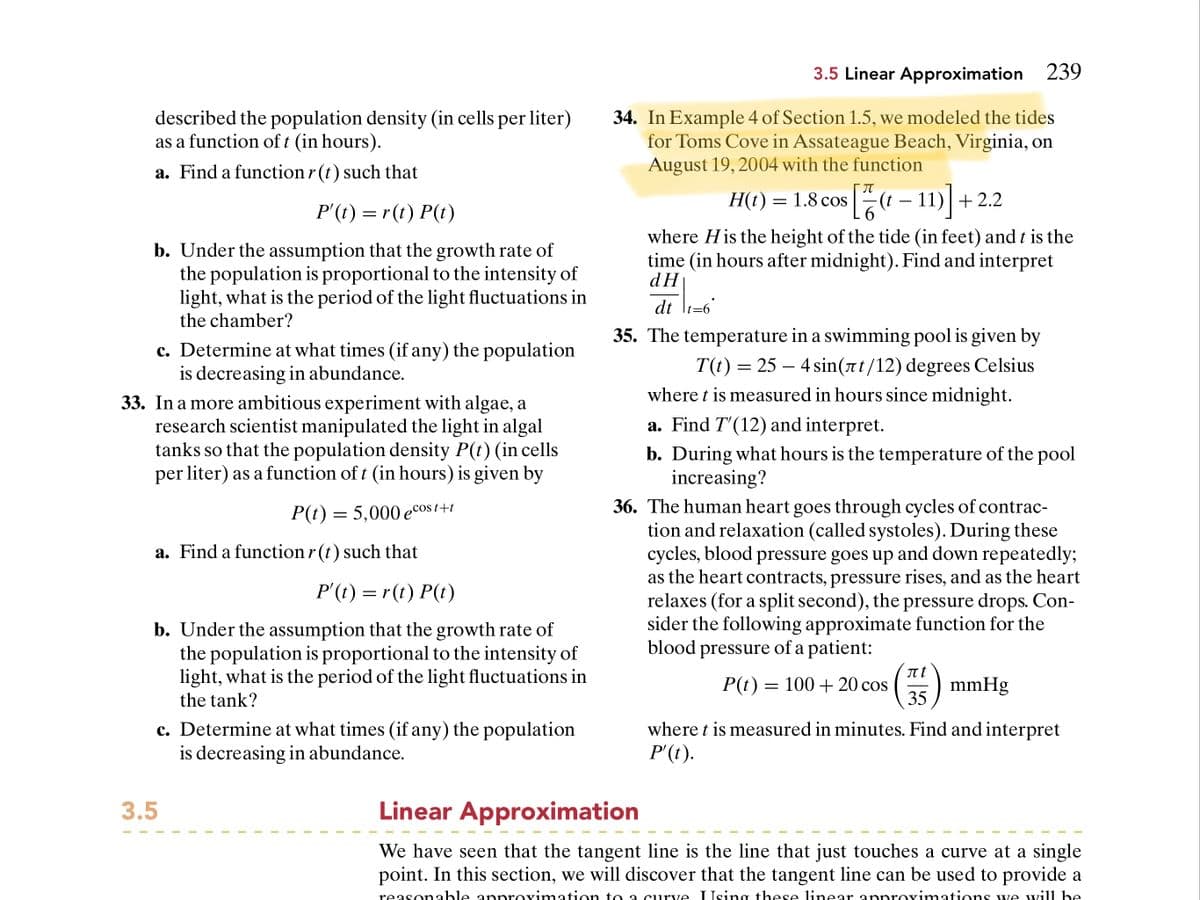34. In Example 4 of Section 1.5, we modeled the tides for Toms Cove in Assateague Beach, Virginia, on August 19, 2004 with the function H(t) = 1.8 cos [( – 11] + 2.2 where His the height of the tide (in feet) and t is the time (in hours after midnight). Find and interpret dH dt l=6
34. In Example 4 of Section 1.5, we modeled the tides for Toms Cove in Assateague Beach, Virginia, on August 19, 2004 with the function H(t) = 1.8 cos [( – 11] + 2.2 where His the height of the tide (in feet) and t is the time (in hours after midnight). Find and interpret dH dt l=6
Linear Algebra: A Modern Introduction
4th Edition
ISBN:9781285463247
Author:David Poole
Publisher:David Poole
Chapter7: Distance And Approximation
Section7.3: Least Squares Approximation
Problem 32EQ
Related questions
Question
Question 34

Transcribed Image Text:3.5 Linear Approximation 239
described the population density (in cells per liter)
as a function of t (in hours).
34. In Example 4 of Section 1.5, we modeled the tides
for Toms Cove in Assateague Beach, Virginia, on
August 19, 2004 with the function
a. Find a function r (t) such that
IT
Н(() — 1.8 сos
– 11) +2.2
P'(t) = r (t) P(t)
b. Under the assumption that the growth rate of
the population is proportional to the intensity of
light, what is the period of the light fluctuations in
the chamber?
where His the height of the tide (in feet) and t is the
time (in hours after midnight). Find and interpret
dH
dt lt=6
35. The temperature in a swimming pool is given by
c. Determine at what times (if any) the population
is decreasing in abundance.
33. In a more ambitious experiment with algae, a
research scientist manipulated the light in algal
tanks so that the population density P(t) (in cells
per liter) as a function of t (in hours) is given by
T(t) = 25 – 4 sin(nt/12) degrees Celsius
where t is measured in hours since midnight.
a. Find T'(12) and interpret.
b. During what hours is the temperature of the pool
increasing?
36. The human heart goes through cycles of contrac-
tion and relaxation (called systoles). During these
cycles, blood pressure goes up and down repeatedly;
as the heart contracts, pressure rises, and as the heart
relaxes (for a split second), the pressure drops. Con-
sider the following approximate function for the
blood pressure of a patient:
P(t) = 5,000 ecos t+t
a. Find a function r (t) such that
P'(t) = r(t) P(t)
b. Under the assumption that the growth rate of
the population is proportional to the intensity of
light, what is the period of the light fluctuations in
) mmHg
P(t) = 100 + 20 cos
the tank?
c. Determine at what times (if any) the population
is decreasing in abundance.
where t is measured in minutes. Find and interpret
P'(t).
3.5
Linear Approximation
We have seen that the tangent line is the line that just touches a curve at a single
point. In this section, we will discover that the tangent line can be used to provide a
reasonable apnroximation to a curve Using these linear approximations we will be
Expert Solution
This question has been solved!
Explore an expertly crafted, step-by-step solution for a thorough understanding of key concepts.
Step by step
Solved in 2 steps with 2 images

Recommended textbooks for you

Linear Algebra: A Modern Introduction
Algebra
ISBN:
9781285463247
Author:
David Poole
Publisher:
Cengage Learning

Algebra & Trigonometry with Analytic Geometry
Algebra
ISBN:
9781133382119
Author:
Swokowski
Publisher:
Cengage

Functions and Change: A Modeling Approach to Coll…
Algebra
ISBN:
9781337111348
Author:
Bruce Crauder, Benny Evans, Alan Noell
Publisher:
Cengage Learning

Linear Algebra: A Modern Introduction
Algebra
ISBN:
9781285463247
Author:
David Poole
Publisher:
Cengage Learning

Algebra & Trigonometry with Analytic Geometry
Algebra
ISBN:
9781133382119
Author:
Swokowski
Publisher:
Cengage

Functions and Change: A Modeling Approach to Coll…
Algebra
ISBN:
9781337111348
Author:
Bruce Crauder, Benny Evans, Alan Noell
Publisher:
Cengage Learning